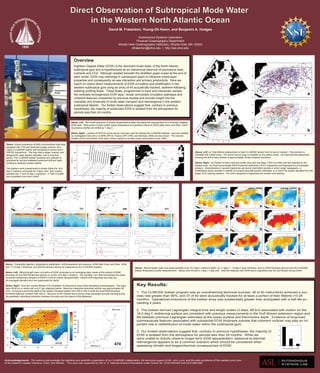
Direct Observation of Subtropical Mode Water in the Western North Atlantic Ocean
- 1. Direct Observation of Subtropical Mode Water in the Western North Atlantic Ocean David M. Fratantoni, Young-Oh Kwon, and Benjamin A. Hodges Autonomous Systems Laboratory Physical Oceanography Department Woods Hole Oceanographic Institution, Woods Hole, MA 02543 dfratantoni@whoi.edu | http://asl.whoi.edu Acknowledgements: The authors acknowledge the logistical and scientific cooperation of our CLIMODE collaborators, the technical support of Mr. John Lund, and the able assistance of the captains and crew of the research vessels Oceanus, Knorr, and Atlantis. This work was supported by the U. S. National Science Foundation under Grants No. OCE-0424492 and OCE-0961090. Overview Eighteen Degree Water (EDW) is the dominant mode water of the North Atlantic subtropical gyre and is hypothesized as an interannual reservoir of anomalous heat, nutrients and CO2. Although isolated beneath the stratified upper-ocean at the end of each winter, EDW may reemerge in subsequent years to influence mixed layer properties and consequently air-sea interaction and primary productivity. Here we report on recent direct measurements of EDW circulation and stratification in the western subtropical gyre using an array of 40 acoustically-tracked, isotherm-following, bobbing profiling floats. These floats, programmed to track and intensively sample the vertically-homogenized EDW layer, reveal convoluted circulation pathways and coherent features unresolved by previous studies and provide insight into the character and timescale of mode water transport and reemergence in the western subtropical Atlantic. Our limited observations suggest that, contrary to previous hypotheses, the majority of subducted EDW is isolated from the atmosphere for periods less than 24 months. Above: Visual comparison of (left) a conventional Argo float equipped with CTD and dissolved oxygen sensors, and (right) a CLIMODE bobber with temperature sensor and a RAFOS hydrophone. The Argo float is larger, heavier, and designed for deep isobaric operation over a long time period. The CLIMODE bobber hardware and software is optimized for actively-ballasted isothermal drift and rapid profiling at relatively shallow depths. The bobbers were programmed to closely follow the 18.5 deg C isotherm continually for 3 days, then “bob” quickly between the 17 and 20 deg C isotherms. A 1000 m profile was completed once each month. Above, Left: (a) Total lifetime displacement of each CLIMODE bobber from its launch location. Final position is indicated with a filled circle. The sound source array is indicated by the yellow circles. (b) Argos-derived trajectories showing the drift of each bobber at approximately 30-day temporal resolution. Above, Right: (a) Position of each valid bob profile (blue dot) and deep (1000 m) profile (red dot) reported by the bobber array. (b) Final record-length RAFOS-derived isothermal (18.5C) trajectories and fragments for all trackable bobbers. Discontinuities in several trajectories are due to intermittent periods in which range, topography, or stratification issues resulted in inability to compute accurate position estimates, or in which the bobber deviated from the target 18.5C parking isotherm. The colors assigned to trajectories are random and arbitrary. Above: Composite trajectory, temperature stratification, drift temperature and pressure, EDW (after Kwon and Riser, 2004) and 17-19 deg C thickness, and RAFOS-derived velocity as measured by four CLIMODE bobbers. Below, Left: Record-length mean circulation of EDW computed by bin-averaging daily values of the product of EDW thickness (h) and RAFOS-derived velocity (u) on the 18.5 deg C isotherm. The resulting <uh> field summarizes the mean horizontal (isothermal) transport of EDW in units of volume transport/width. Vectors with magnitude less than the bin-averaged standard error are suppressed for clarity. Below, Right: Over four months Bobber 474 completed 10 anticyclonic loops while translating southwestward. The loops were 40-50 km in radius with a 9-11 day rotational period. Maximum measured azimuthal velocity was approximately 55 cm/s. During this period the depth of the bobber increased slightly from 300 to 330 m while the local EDW thickness remained relatively constant near 300 m. Recovery of the moored sound source array prevented acoustic tracking during the potentially interesting interaction between this eddy and the islands of the Bahamas. Above: Record-length mean and seasonal fields of (a) 18.5 deg C isotherm depth, (b) 17 deg C – 19 deg C layer thickness, and (c) EDW thickness derived from the CLIMODE bobber temperature profile measurements. Values were binned in 2 deg x 2 deg cells. Note the relatively thick EDW layers originating near the Gulf Stream during winter. Key Results: 1. The CLIMODE bobber program was an overwhelming technical success: 38 of 40 instruments achieved a suc- cess rate greater than 90%, and 37 of 40 were acoustically tracked for at least a portion of their lifetime (10-26 months). Operational endurance of the bobber array was substantially greater than anticipated with a half-life ex- ceeding 4 years. 2. The bobber-derived Lagrangian integral time and length scales (3 days, 68 km) associated with motion on the 18.5 deg C isothermal surface are consistent with previous measurements in the Gulf Stream extension region and fall between previous Lagrangian estimates at the ocean surface and thermocline depth. Evidence of long-lived submesoscale features associated with substantial EDW thickness indicate that coherent vortices may play an im- portant role in redistribution of mode water within the subtropical gyre. 3. Our limited observations suggest that, contrary to previous hypotheses, the majority of EDW is isolated from the atmosphere for periods less than 24 months. While we were unable to directly observe longer-term EDW sequestration, seasonal-to-biennial reemergence appears to be a common scenario which should be considered when assessing climatic and biogeochemical consequences of EDW. Below, Left: Ten-month sequence of bobber temperature profiles illustrating the sequestration of a minimally stratified EDW layer. Bold portion of each profile meets temperature and gradient criteria for EDW (after Kwon and Riser, 2004). Successive profiles are shifted by 1 deg C. Below, Right: Location of RAFOS sound source moorings used for tracking the CLIMODE bobbers. Sources installed by investigators from the U.S (EPB, EPC3), France (AP3, AP5), and Germany (IM8) are also shown. The nominal location of the Gulf Stream north wall is shown based on monthly-mean observations since 1966.
